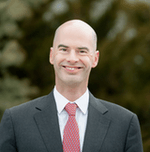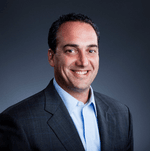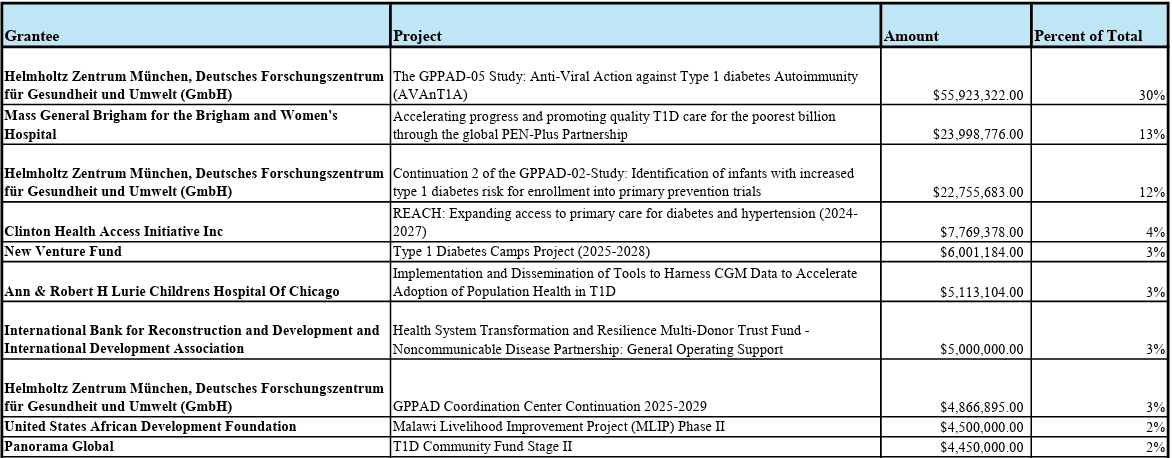
At a Glance
- The Helmsley Charitable Trust is a global philanthropic entity that distributes grants to projects in six major areas, one of which is type 1 diabetes (T1D).
- Helmsley has given $1.4 billion to T1D since grant-giving began in 2009.
- In 2024, T1D research received $188 million, 42% of all grants given last year ($450 million).
- The T1D community is fortunate Helmsley continues to uphold T1D as a major program area when any other could be chosen.
May 29, 2025
The Leona M. and Harry B. Helmsley Charitable Trust is one of the largest contributors to T1D research, in some years giving more than the National Institutes of Health and Breakthrough T1D. We in the T1D community are fortunate and appreciative that the Trust continues to make T1D a top priority.
Helmsley is a private, perpetual trust that can distribute its funding as it chooses. It had a substantial endowment of $7.3 billion at the end of 2024. Three trustees leading Helmsley have the power to direct grants to any disease area or public health initiative they choose. Today, there are six focus areas, one of which is T1D.
To date, Helmsley has dedicated $1.4 billion to T1D research. In 2024, it gave $188 million.
Background
Helmsley was established in 1999 by Leona Helmsley, a real estate developer and heiress who was deeply committed to philanthropy. The Trust began active grantmaking in 2009 after the passing of Leona, who left nearly all her estate assets to the Trust.
Three trustees lead and manage the operations. Two of the trustees are Leona’s grandchildren, David and Walter Panzirer. The third trustee is Sandor Frankel, long-serving attorney for Leona and the Helmsley Trust (see Appendix A). David Panzirer has two children battling T1D.
The Trust fulfills its mission through six major program areas. The mission is committed “to helping people live better lives today and creating stronger, healthier futures for individuals and communities.” The six major program areas are:
- Crohn’s Disease
- Israel
- Rural Healthcare
- Type 1 Diabetes
- Vulnerable Children in Sub-Saharan Africa
- New York City
Each program area is managed by a team of professionals led by one of the three trustees. Additionally, Helmsley has an investment team managing its endowment and a professional services staff to handle back-office operations like finance, accounting, and HR.
T1D: A Top Priority
Helmsley has given grants to T1D every year since 2009, without exception. Annual giving has ranged from $13 million to $243 million (see chart A). In many years, it was the most heavily funded program area.
Chart A: Historical View of T1D-Specific Helmsley Grants (2009-2024)
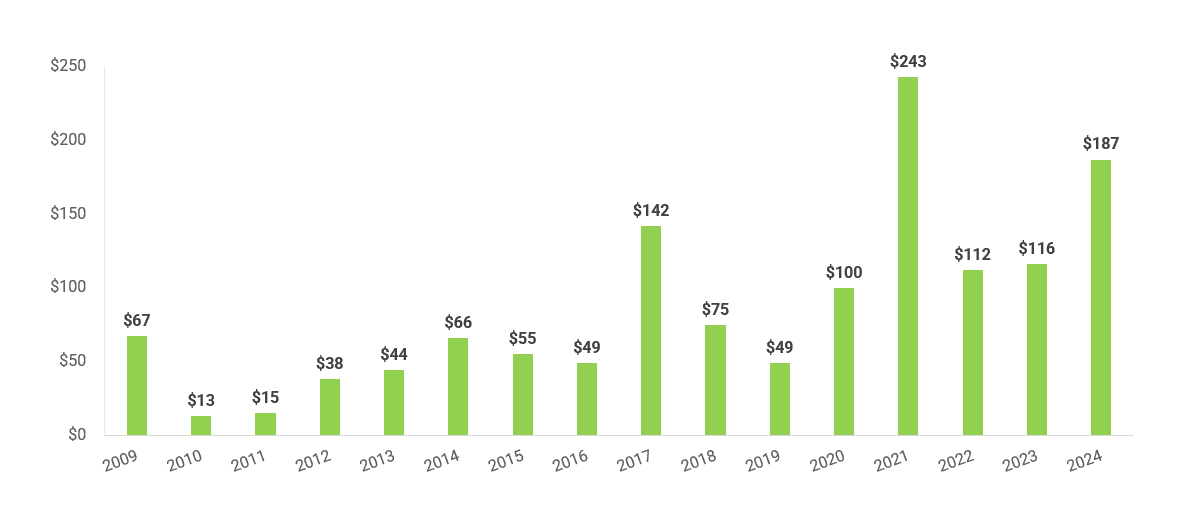
In 2024, the Trust gave $188 million in grants to T1D, representing 42% of total giving. T1D was the most heavily funded program area in 2024, followed by Rural Healthcare at 17% (see chart B).
Chart B: 2024 Program-Specific Grant Funding as Percentage of Total ($450 Million)
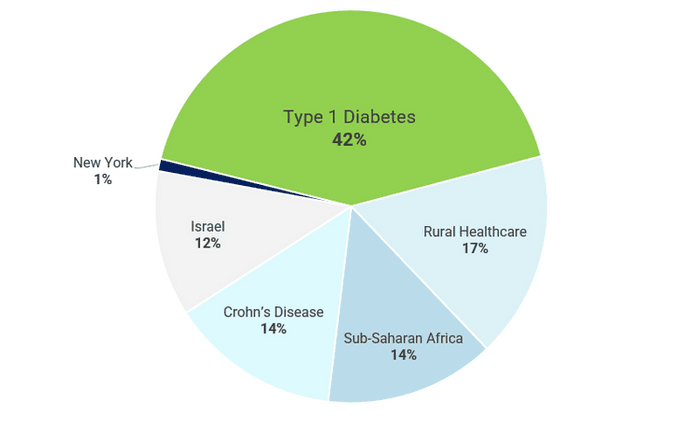
T1D Program Objectives
The Trust states there are three T1D program priorities that guide grant making.
1. Transforming the Trajectory
Preventing the development or delaying the progression of type 1 diabetes.
2. Improving Access to Care and Technology in the U.S.
Improving the lives of people living with T1D in the U.S. through better management and improved health care systems.
3. Achieving Equitable Access in Low- and Middle-Income Countries
Ensuring people living with T1D in lower-income countries have access to care and lifesaving medicines.
In 2024, forty-two individual T1D grants were given. Based on our analysis, most of these grants were used to fund the first priority, Transforming the Trajectory. Transforming received $136 million through 25 separate grants, amounting to 72% of all T1D grants given in 2024. The second and third priorities received 17% and 11%, respectively. One Practical Cure project was funded in 2024.
The Largest Grants
The five largest individual grants in 2024 represented 62% of total T1D funding in 2024 (see chart C). The Helmholtz Zentrum München research facility, based in Munich, Germany, was the highest recipient, winning two of the top 5 grants. Both Helmholtz projects attempt to delay and prevent T1D.
The three other top projects seek to enhance access to care and provide support programs for T1D. The Pen-Plus partnership focuses on improving access to care for the poor; the Clinton Initiative expands access to care globally; and the T1D Camps project provides support to camps nationwide for low-income youth living with T1D.
Chart C: Top 5 T1D Grants in 2024 ($ Millions)
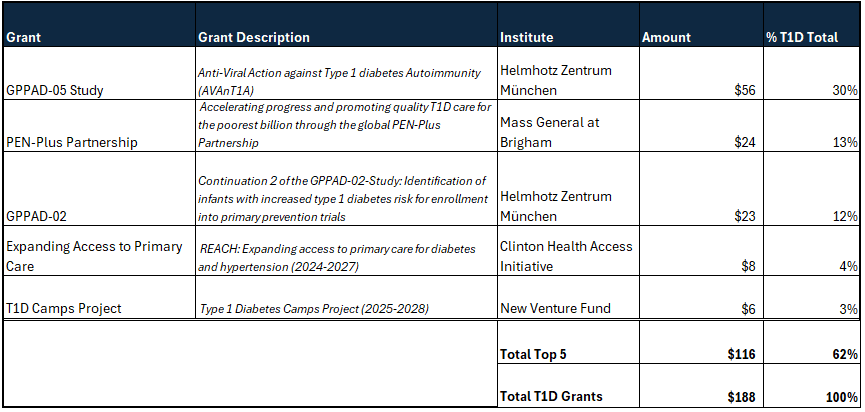
Practical Cure Project
One project funded by the Trust has the potential to become a Practical Cure. A $1.5 million grant was made to Uppsala University for a project aiming to hide transplanted beta cells from the immune system. This project, UP421, is currently in human trials.
The project is a collaboration with Sana Biotechnology. The current trial is testing cadaver-sourced islets that are gene-edited before transplantation to evade detection from the immune system. Early results are promising, but there is still a long way to go.
To date, one patient has been dosed: A forty-two-year-old man diagnosed with T1D at age four. The latest results showed the transplanted islets continued to survive and produce insulin at the 12-week mark, the longest stretch in human trial history in a patient with established T1D, without full-body immunosuppression. The next steps are to expand the number of trial participants and move to testing a sustainable cell supply, which is planned for 2026.
Opportunity
Helmsley has the power and capability to push forward any research area on which it focuses. It is unique in this regard; few other organizations have both the muscle and commitment to do so for T1D. Again, we in the T1D community are lucky to have them.
With sustainable cell supply around the corner, Helmsley is in a unique position to turbo-boost novel autoimmune solutions like UP421. Once beta cells are widely manufactured, there will be a need for a coordinating leader to ensure the cells are available for testing, and with a plan in place to make it happen. Helmsley is uniquely capable of making this happen, should their trustees make it a priority.
Appendix A: Trustees
Appendix B: Helmsley T1D Grants 2024

